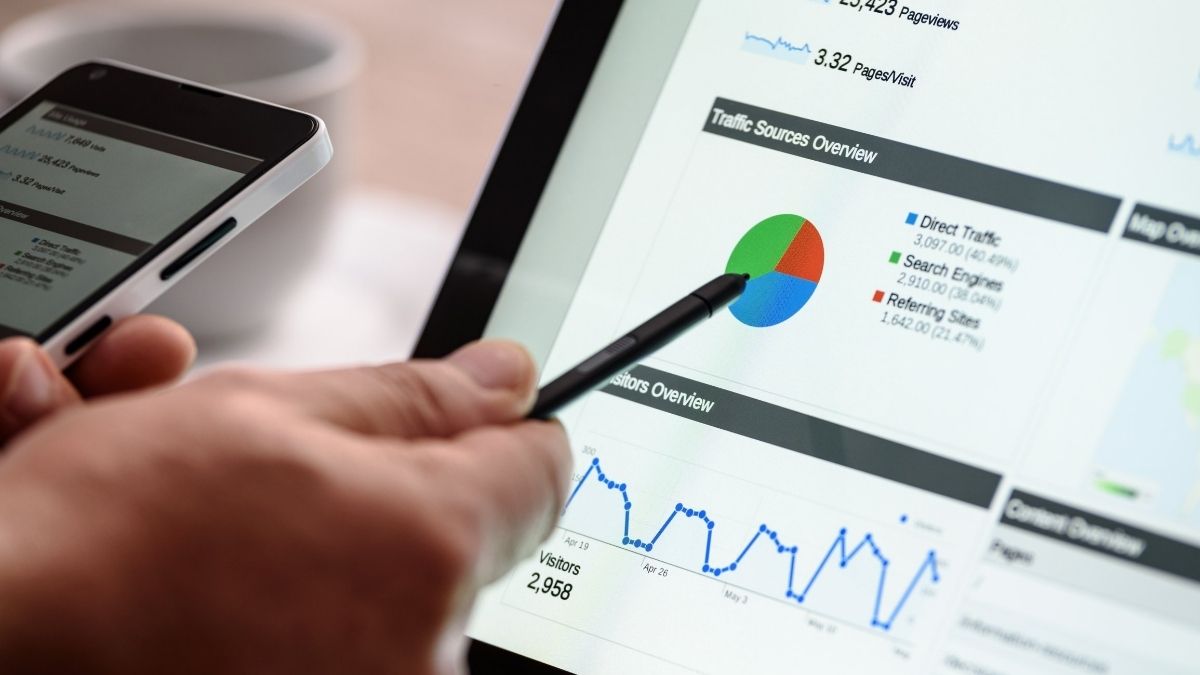
If you’ve been using Google Ads for any length of time, you’ve most likely used Google Ads Editor. It’s a desktop application that’s extremely useful for managing campaigns and making large-scale changes.
So, how can you make the most of this tool and all of its features?
This guide will teach you how to use Google Ads Editor, how to use basic features, how to create new builds offline, and much more.
What exactly is Google Ads Editor?
Google Ads Editor is a Google Ads account offline editor.
Instead of making changes in the online UI, you can make them in Editor offline and then post them in bulk.
Advertisers can also use Editor to work on multiple accounts at the same time.
How Google Ads Editor Began
All we had in the early days of Google Ads (formerly known as Google AdWords) was the online interface.
As an in-house PPC manager, I began managing Google Ads campaigns in 2002, and it was so successful for us that we quickly expanded our account to represent all of our products.
Managing so many campaigns became cumbersome very quickly. Any changes we made were immediately implemented – there was no way to review the work before it went live.
And there was no way to make large-scale changes. Everything had to be hand-edited, one change at a time.
We hired an intern to assist us with pricing changes in our ads.
Google Ads Editor (then known as AdWords Editor) was released in early 2006.
Every search marketer rejoiced. Finally, bulk editing would be a lot simpler.
Read: Should Brands Still Invest In Offline Marketing: What Marketing Gurus Say.
Why Use an Offline Editor?
It turns out that Google Ads had been using an internal version of Editor for quite some time. Advertisers could send bulk changes to their reps, who could then make the changes using Editor.
Google eventually realized that allowing advertisers to make bulk changes themselves would be more efficient.
As accounts became more complex, the editor was a godsend for advertisers.
Using Google Ads Editor for the First Time
To begin using Google Ads Editor, you must first download it from Google Ads.
After downloading the tool, you will be prompted to log in and download your Google Ads accounts from your My Client Center (MCC).
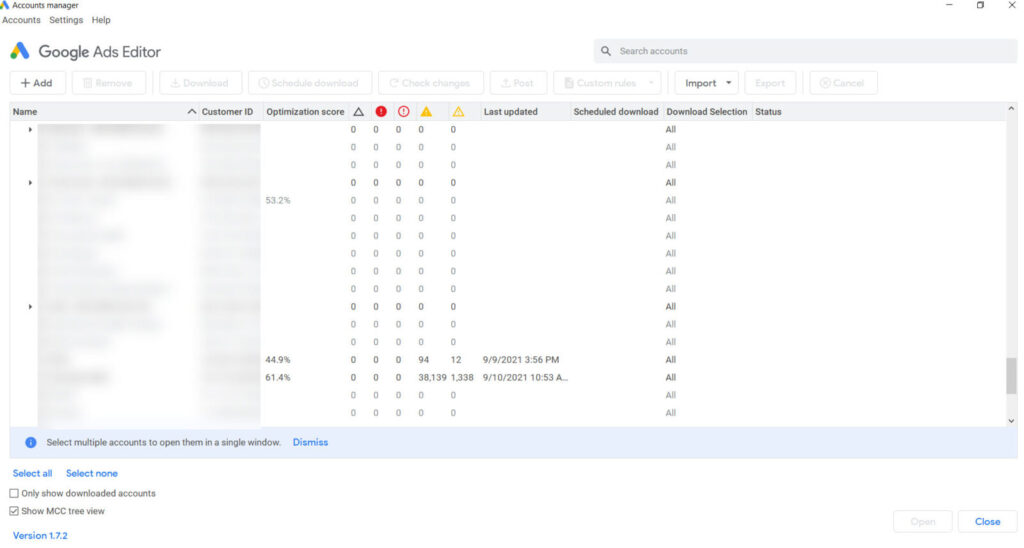
The Accounts Manager displays all of the accounts in your MCC, as well as an optimization score, statistics on the most recent data updated, and any errors.
Simply select the account you want to work on and press the “Open” button to import it into Editor.
The Fundamentals of Using Google Ads Editor
After you’ve downloaded the account, you’ll see the following screen:
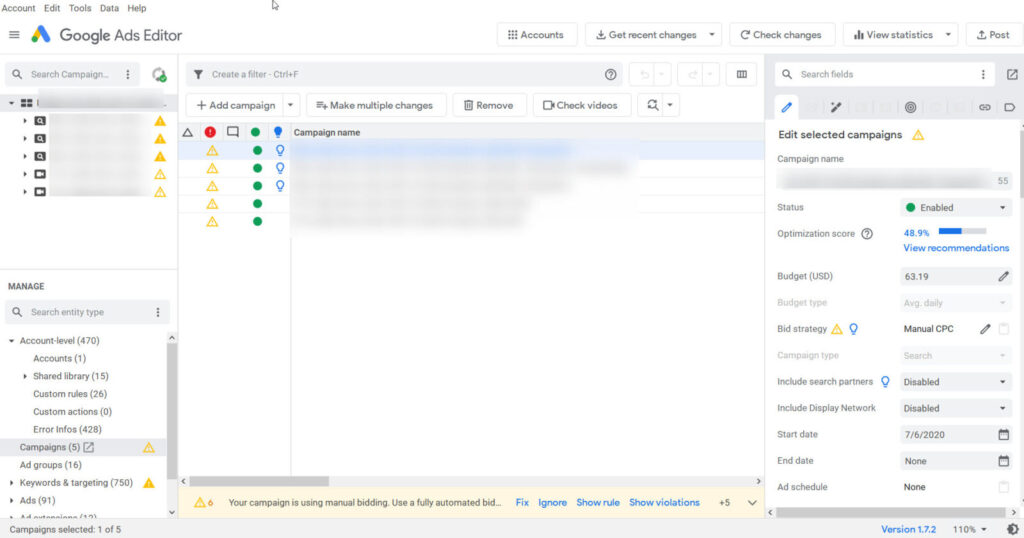
One of my favorite features of Editor is the ability to see your entire account at a glance and easily expand or collapse various elements such as campaigns, ad groups, ads, and keywords.
All of your campaigns will be listed in the left navigation, along with an icon indicating the campaign type:
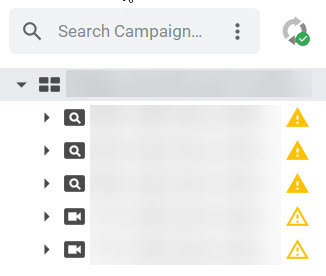
The magnifying glass represents a search campaign, while the video camera represents a YouTube campaign. There is also a display campaign icon.
You can find a campaign in the left navigation menu by entering a search term or the campaign name into the Search Campaign box at the top.
There is also an icon that indicates whether or not the account has been synced.
Syncing is necessary to ensure that any changes made directly in Google Ads have been imported into Google Ads Editor.
We’ll go over syncing in more detail later in this article.
To view a campaign’s ad groups, simply click the arrow to the left of the campaign name:
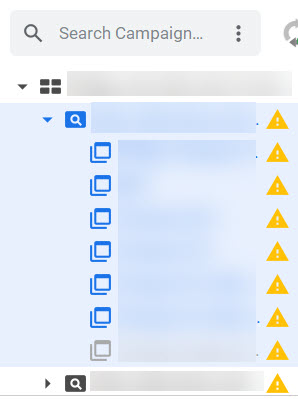
You can now see all of the ad groups in the campaign.
Other elements of your Google Ads account, such as keywords, ads, targeting, and so on, can be found below the top left menu:
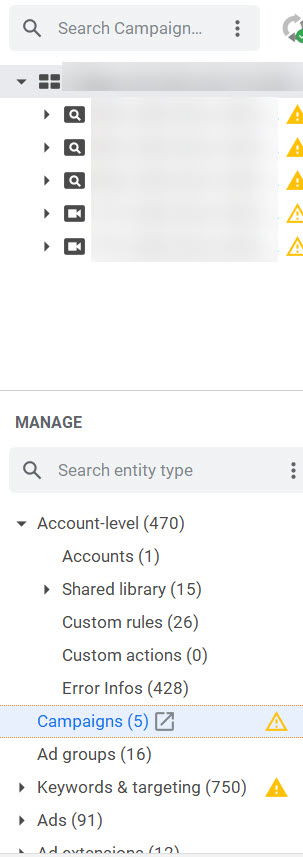
When you select a campaign or ad group in the top left, the information in the bottom changes – you’ll only see information for the selected campaign.
This account has five campaigns, 16 ad groups, 750 keywords and targeting, and 91 ads in total.
When you select an element from the lower left, details will appear in the center and right-hand sections of Editor:
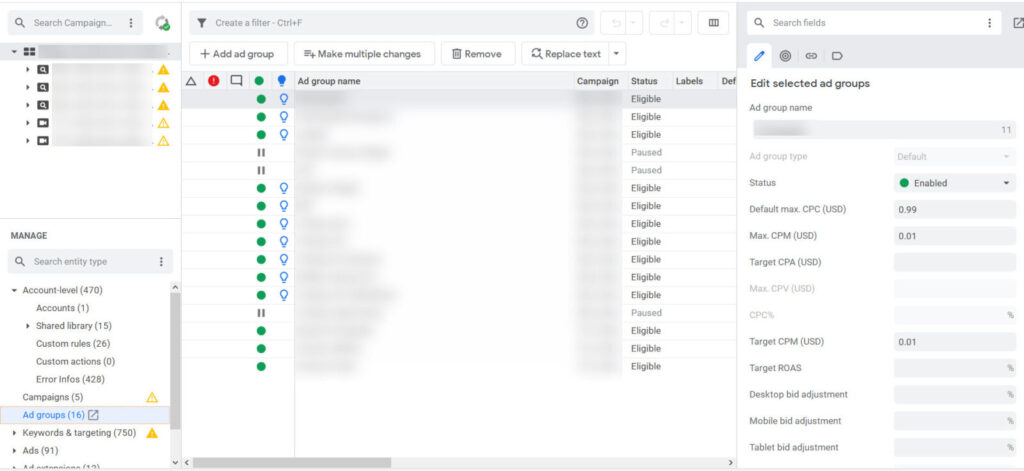
I’ve chosen “Ad groups” for the entire account in this example.
I can see all of the ad groups, as well as their status, in the center (green dot for active, hash marks for paused).
On the right, I can choose an ad group and make changes to any of the fields displayed.
When you select multiple elements (in this case, ad groups), you can make bulk changes all at once.
Assume I wanted to set all of the bids for every ad group in the account to the same amount. I simply select all of the ad groups in the center and make the following change in the right:
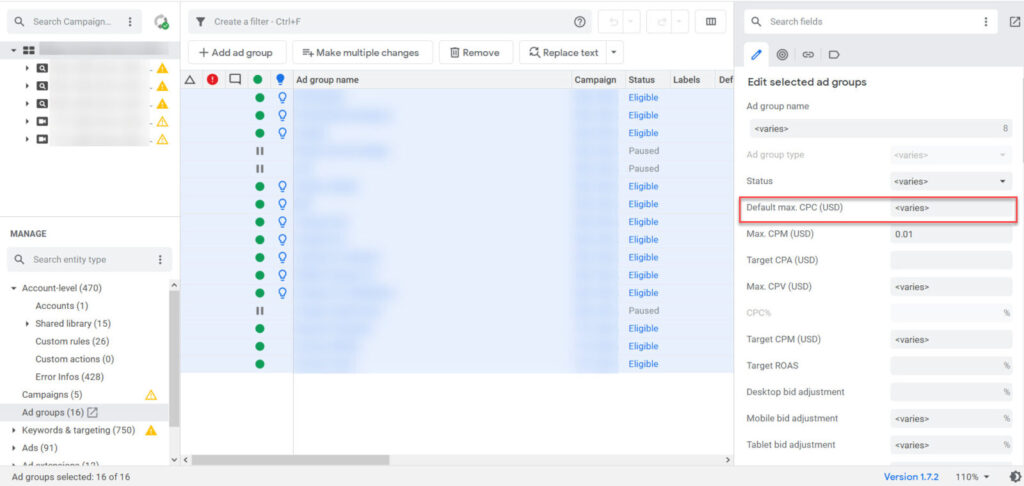
Then, in the Default Max CPC box shown above, enter the desired bid, which will update all ad group bids to the same amount.
This method allows you to perform a plethora of bulk edits.
Assume I wanted to change all of the final URLs for each ad in each campaign to the same URL.
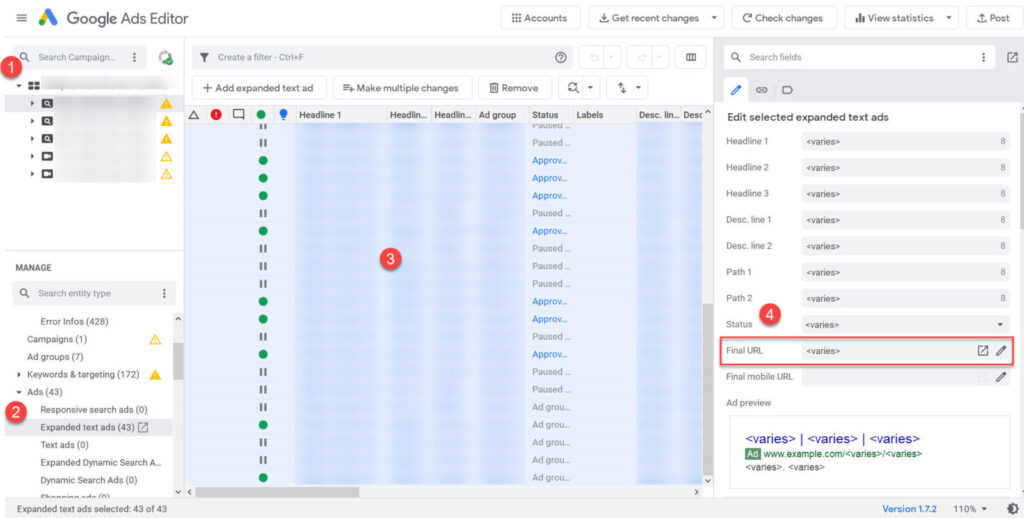
First, as shown in number one above, select the campaign from the left nav.
Next, in the lower-left nav, select Ads and then the type of ads you want to update, as shown in number two. (Note that you must edit each ad type separately: RSA, ETA, Dynamic Search, and so on.)
Then, as shown in step three, select all of the ads in the center section.
Finally, in the right nav, change the Final URL to the new URL as shown in step four.
Making Changes and Publishing Them
You might be thinking as you read this, “I can do all of these things in the online Google Ads UI.” “Why would I want to work with this Editor?”
The difference is that changes made in the online UI are immediately reflected.
As previously stated, the benefit of using Google Ads Editor is that all changes are made offline. This allows you to double-check your work for errors before publishing it.
We’ve all made a change that we’ve had to go back and undo – and it can be a daunting task at times. Using Editor greatly reduces the possibility of error.
New Hire Training
I enjoy using Editor to train new employees. Not only is it simple to see and understand the account structure in Editor, but it also aids in QA-ing a trainee’s work.
Changes made in Editor are retained on the user’s local device until they are published to Google Ads. They are not visible to other Google Ads account users.
If you’re working alongside the trainee in person, you can see their changes in Editor before they go live.
If you’re remotely training someone, you can have them upload their changes in a paused state, import them to your local Editor, check them, and then change the status to Active.
To publish changes made in Editor, click Post in the upper right-hand corner, followed by Post in the dialog box:
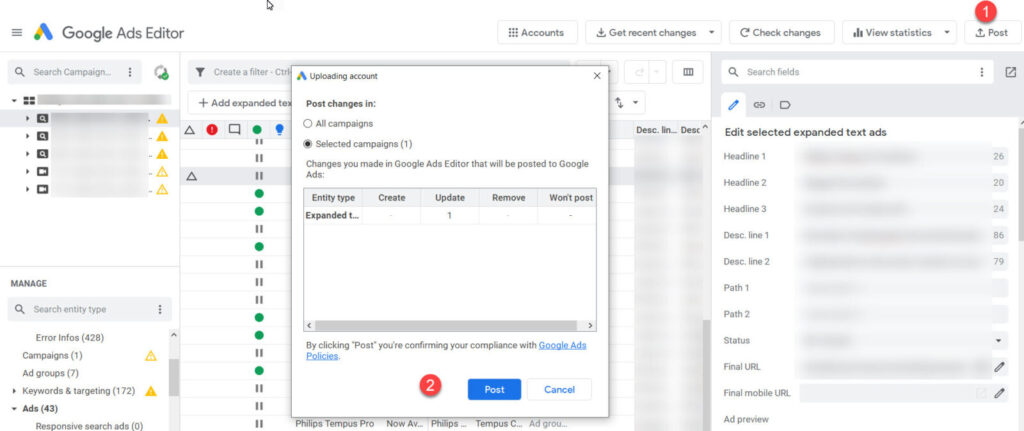
To post the correct changes, make sure to select All Campaigns or Selected Campaigns.
Do you need to undo a change? Above the center section, there is an Undo button:

Just make sure to Undo before posting the changes; once posted, changes cannot be undone from the Editor.
View and Change Preferences
Google Ads Editor is an excellent tool for viewing and editing campaign settings. In an earlier article, 10 Tips for a Fresh Start After a Google Ads Account Takeover, I discussed using Editor to audit settings.
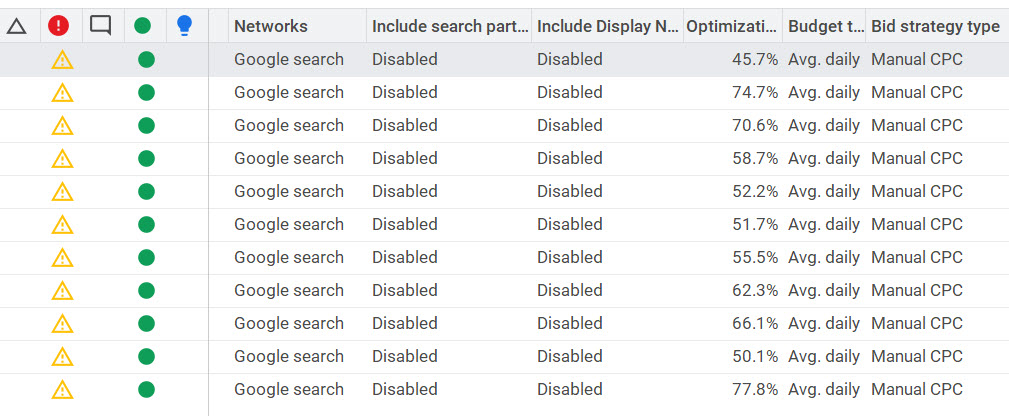
Google Ads Editor Filtering
If you work in large Google Ads accounts, looking at the entire account at once can be overwhelming, especially if there are a lot of paused campaigns.
When I first open one of our enterprise accounts, I notice the following:

The entire screen is taken up by campaigns that have been paused. This is inconvenient when I’m trying to work on active campaigns.
This is where filters come into play.
You can make a filter for almost anything:
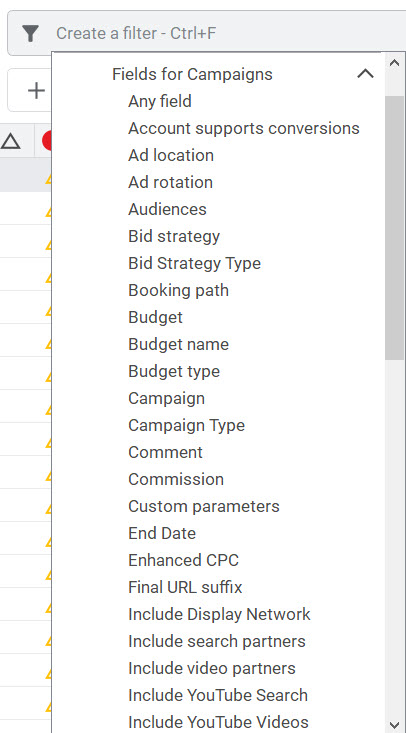
That’s only through the alphabet’s I’s!
One filter I frequently use displays only enabled entities such as campaigns, ad groups, keywords, and so on:

This filter is extremely useful when working in large accounts with a large number of paused entities.
To make a filter, choose your options and then click the Save icon:

Statistics Import into Google Ads Editor
We’ve covered a variety of methods for viewing and editing your Google Ads account.
“This is fine,” you may be thinking, “but wouldn’t I want to see performance data if I’m working on my account?”
Yes, you would, and you certainly can!
View Statistics in Google Ads Editor allows you to import performance statistics.
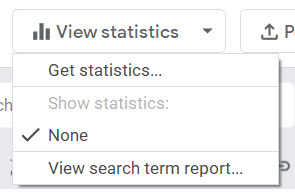
None is selected by default, but if you click on Get statistics, you will be presented with several options:
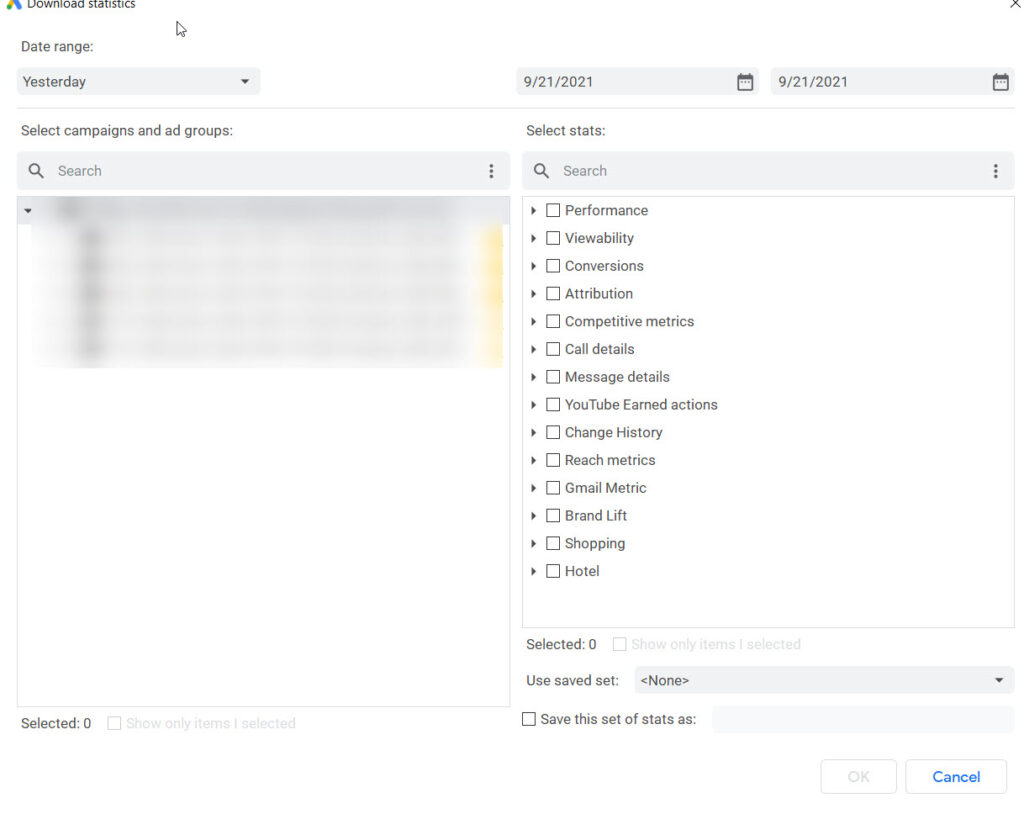
At the top left, you can select a date range and then the statistics you want to see in Editor. You can also save the set of stats for later viewing.
Viewing stats in Google Ads Editor enables you to make optimization decisions in the same way that you would in the online UI.
In this case, I’ve selected all of the stats from the Performance drop-down:
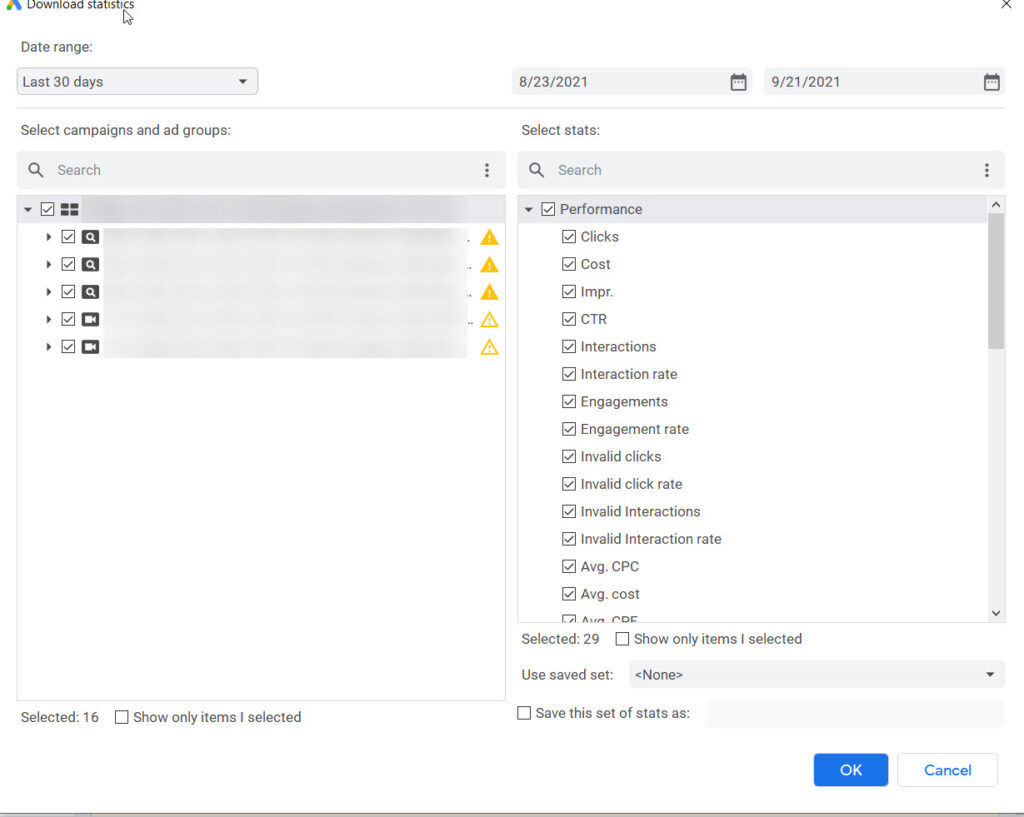
In the left-hand section, make sure to check the box next to the campaigns for which you want to view statistics.
Create New Builds in Google Ads Editor
The ability to create new builds offline is one of the most useful features of Google Ads Editor.
Uploads in Editor do not activate until you post them, unlike the online UI, where they go live immediately unless you set their status to Paused.
This allows you to double-check your work and even have someone else double-check it before posting it.
Excel is used by many PPC managers to create campaigns, ad groups, keywords, and ad copy.
Excel is an excellent campaign development tool because it is simple to sort, filter, organize, and measure the length of each field.
Simply ensure that your Excel sheet has the correct column headings, and you’ll be able to easily import your new campaigns into Editor.
I prefer to begin a new build with keywords. In Editor, you can create new campaigns and ad groups at the same time as you create keywords.
The column headings I use are as follows:

You could also include columns for status, bid, and other relevant information.
To upload from a spreadsheet, go to Keywords in the left column of Google Ads Editor and click Make multiple changes.
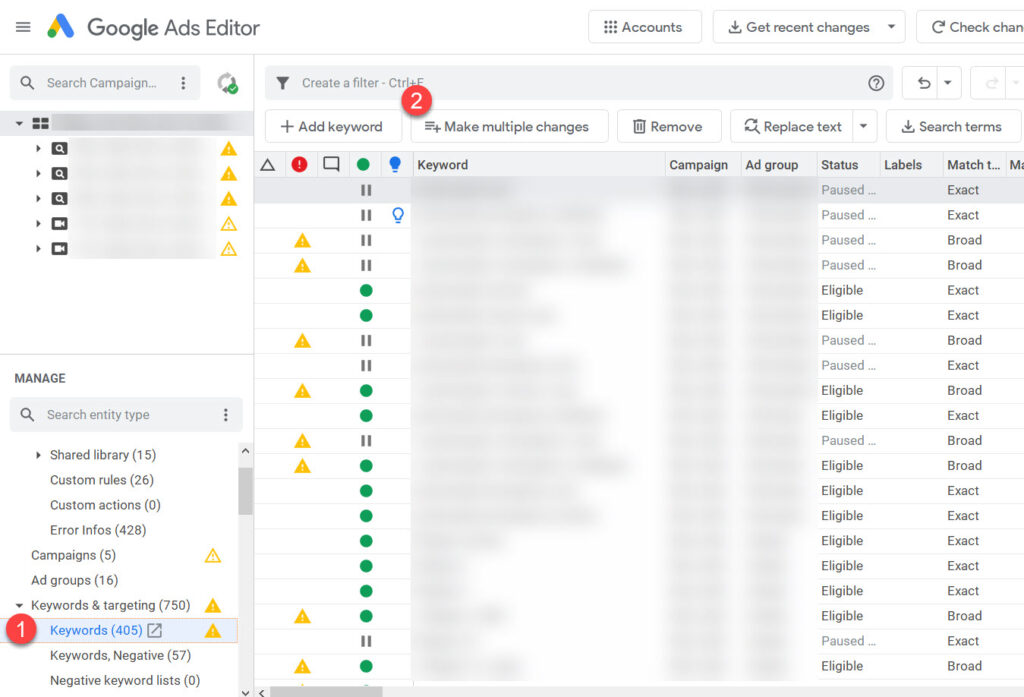
To upload from a spreadsheet, go to Keywords in the left column of Google Ads Editor and click Make multiple changes.
Then, double-check that everything was properly pasted before clicking Process. You’ll have the opportunity to review your changes before they’re published to Google Ads.
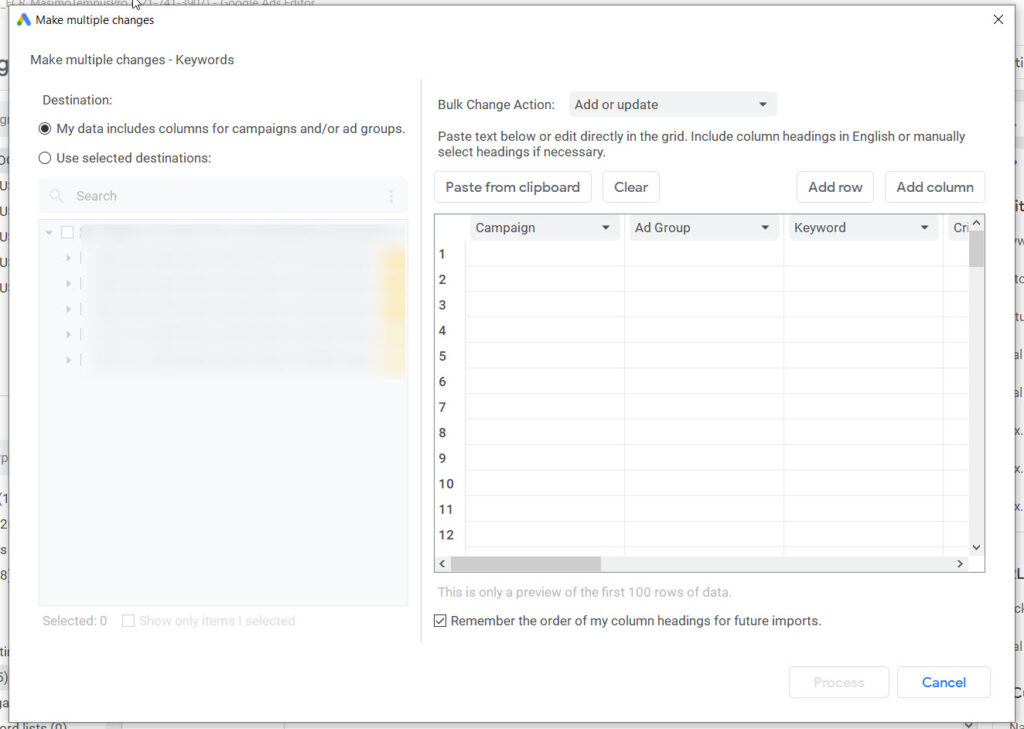
You can also upload elements to existing campaigns and ad groups by using the Make multiple changes feature. There are two approaches to this.
To begin, you can use the exact campaign and ad group names from the account and follow the steps outlined above. The editor will recognize these as existing and place the new keywords, ads, or other elements in the appropriate location.
Alternatively, in the upper left of the Make multiple changes menu, select Use selected destinations.
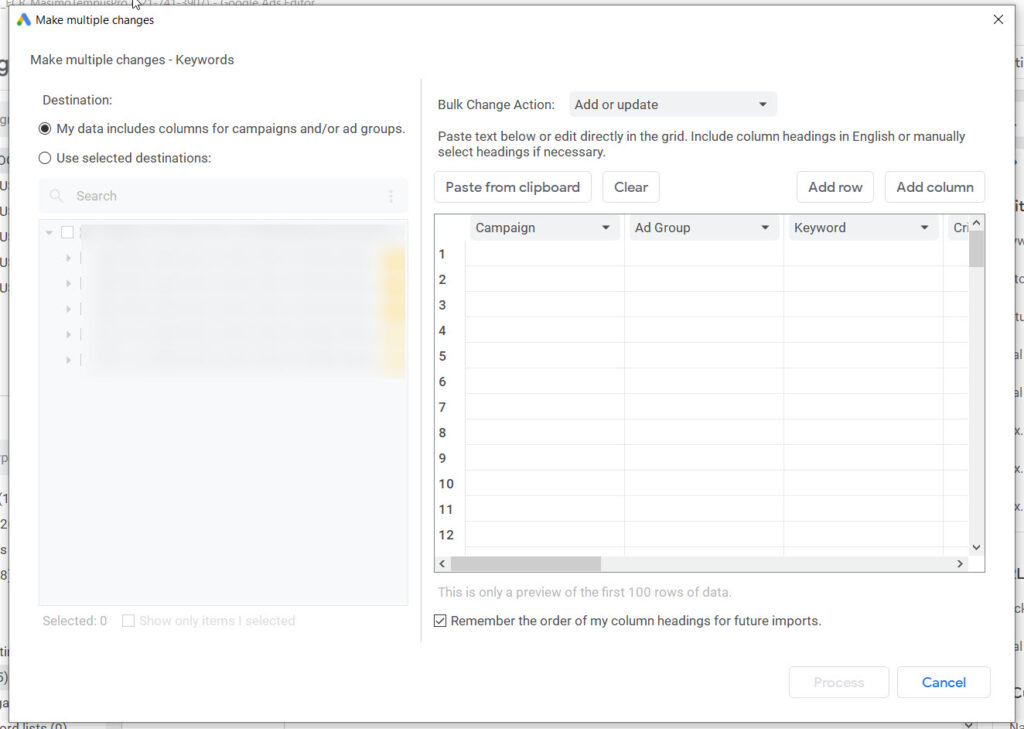
Choose the ad group(s) or campaign(s) to which you want to add elements, then copy and paste.
Google Ads Editor allows you to preview your changes before publishing them. You can check for and correct errors before posting.
Choose the ad group(s) or campaign(s) to which you want to add elements, then copy and paste.
Google Ads Editor allows you to preview your changes before publishing them. You can check for and correct errors before posting.

Locate and Replace
The find and replace function in Google Ads Editor is one of my favorite features.
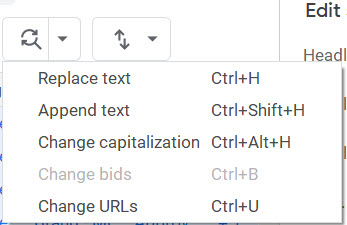
You can change the text, replace it, append it, change the capitalization, or change the URLs.
Replace text is useful if you need to change a word or phrase in ad copy or keywords, or even in campaign and ad group naming conventions.
Append text is particularly useful when appending URL tracking parameters to a URL or entity name.
You can change the capitalization to title case, sentence case, or all lower case.
Change URL is an excellent tool for setting URLs, appending text to URLs, and removing URL parameters.
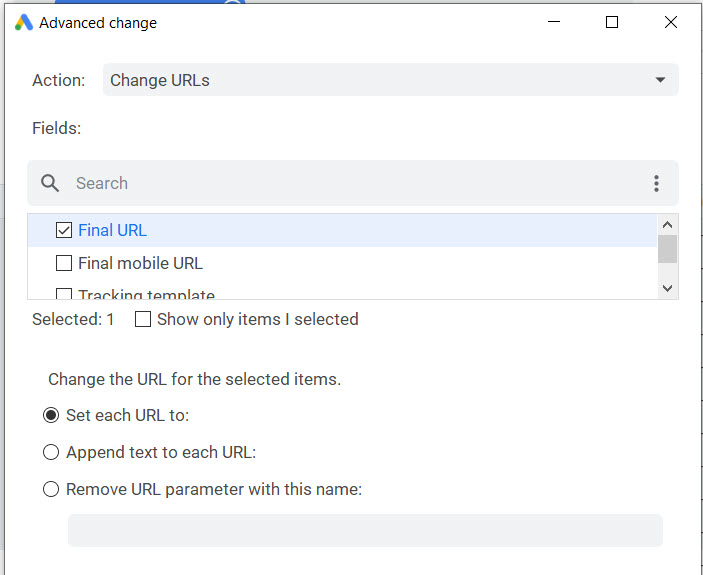
Reminders of Importance
Whew! I hope you can see the power of Google Ads Editor by now. There are a plethora of things you can do with it.
Here are a few things to keep in mind when using Google Ads Editor.
Make sure you have the most recent changes before starting an Editor session!

Keep in mind that Google Ads Editor is an offline editor. It won’t know if you or others made changes to your Google Ads account in the online UI unless you get recent changes:
As seen above, Google does a good job of drawing your attention to the Get recent changes button to remind you. Regardless, make it a habit to always click this as soon as you open the app.
Before you exit the Google Ads Editor app, make sure to save any changes you’ve made. I’m sure every PPC manager has forgotten to do this at least once and then wondered why their changes hadn’t taken effect.
For many tasks, you’ll still want to work in the online UI.
An editor will not replace reporting, graph viewing, billing verification, and many other features available in the online UI.
For maximum efficiency, use both Google Ads Editor and the online UI.
The editor generates a lot of annoying error messages that aren’t “fatal.”
It can be unsettling to see a slew of yellow exclamation mark error messages in Google Ads Editor.

Consider these to be “reminders” rather than “errors.”
This example is from an account where the modified broad match is frequently used. We have a large account where we haven’t yet switched everything to phrase match.
It’s useful to have a reminder to make the switch, but seeing a slew of exclamation points can be intimidating.
It is important to note that red error messages are fatal errors that must be corrected immediately.
Now that you know how to use Google Ads Editor, I hope you will incorporate it into your PPC management workflow regularly.
Need help with our free SEO tools? Try our free Paraphrasing Tool, Online Md5 Generator, Code to Text Ratio Checker.
Learn more from PPC.

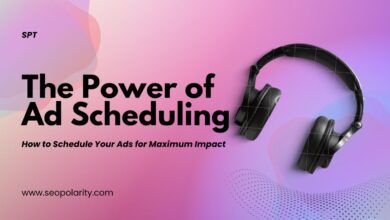

![The 23 Experts' Predictions for the Biggest PPC Trends in 2022 [Ebook]](https://seopolarity.com/blog/wp-content/uploads/2021/11/the-23-experts-predictions-for-the-biggest-ppc-trends-in-2022-ebook-390x220.jpg)
